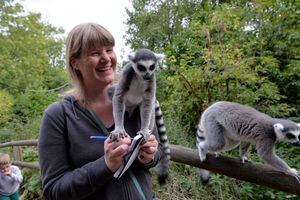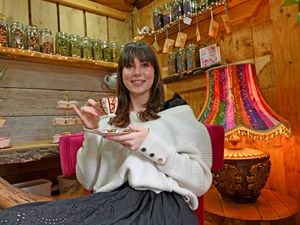It’s feeding time at Dudley Zoo (really)
Ever wondered what a day in the life of a zookeeper is like? When Weekend was invited to go behind the scenes at Dudley Zoo and lend a hand with some of its 1,300 residents, from the cheeky chimps to the playful penguins, we jumped at the chance.

After enrolling as a zookeeper for the day, the first stop is a visit to see female chimpanzees Fanny, Malaika, Mandy, Mali, Barbie, Banika and Binti with senior primate keeper Jodie Dryden who tells me they are in a good mood.
“You can always tell, they are a bit like children, you know if it’s going to be a good day or not,” she says.
I’m taken to see where the primates spend their time when the visitors and keepers have all gone home.
The wild chimps will make a new bed, called a nest, high in the trees every single night using branches they have collected during the day.
And the zoo’s resident group do exactly the same thing in their indoor enclosure with the help of the keepers.
Jodie explains to me that the team will dismantle their beds every day and leave the nesting material, which includes straw and blankets, scattered around so the animals can rebuild them at night.
The chimps, who during the day are free to roam a one-acre paddock, can also get some fresh air in an outdoor off-show area where there are often enrichment activities aimed at encouraging their natural behaviour.
I’m also shown where their food is prepared and how the keepers ensure they are getting a balanced and nutritious diet of vegetables, a small amount of fruit, eggs, cooked potatoes, pasta and rice.
“They really love eggs – they have them hard-boiled in the shells but we sometimes scramble them for them. They love celery, which seems a strange thing for them to enjoy but they do, and peppers,” explains Jodie.
My first zookeeper duty is to give the group their morning drink. Jodie fills a large watering can with water and then adds baby porridge to it.
Yes, you read that correctly. Turns out the chimps are big fans of oats and can’t get enough of porridge. They also love orange squash and having different herbs and spices added to their H20.
It was very funny to see them open their mouths wide so I could pour the drink in and I was doing my best to ensure they all got their fair share.
But some of the ladies are very demanding and will tap on the bars of the enclosure when they feel it’s their turn for a sip, sometimes even holding a finger on the spout to ensure I don’t take it away before they are ready.
One member of the gang, 27-year-old Binti, even gives me her water bottle to fill with the liquid so she could drink from a hole in the bottom.
I’m also shown the different commands they have been taught so the keepers can carry out health checks.
These include shutting and opening their mouths and showing their chests, backs, feet, ears, shoulders, hands and bottoms.
Jodie, who’s been at the zoo for 11 years, says it’s a lot of fun working with the chimpanzees. “No two days are the same, I’m sure every keeper says that but it really is true,” she says.
After saying goodbye to the girls, I’m taken to Lemur Wood. The one-acre woodland is home to 22 free-roaming, enigmatic lemurs and the animals can climb, run and jump around visitors as they walk through the exhibit.
“It’s an established woodland so the lemurs shoot up to the top of the trees like they would do in the wild which is nice to see,” says keeper Deb Pittaway, who moved to the attraction from Twycross Zoo last year.
Deb introduces me to black and white ruffed lemurs Zeb and Yoda. With their soft fur and big eyes, it’s not hard to see why these are immensely popular with visitors.
I offer them some food – specially formulated primate pellets, which provide a correct balance of nutrients.
They are happy to eat it straight from my hand but they are messy eaters with bits of their meal flying everywhere as they chomp away loudly.
It’s lovely to get so close to these intriguing creatures but the peace and quiet of the woodland is about to be shattered.
We are being ambushed – the ring-tailed lemurs had arrived. These nimble-footed creatures are full of energy and before I know it, I have one climbing on my shoulder after pellets before another sits on my reporters notepad and ends up making some interesting doodles with the pen.
The ruffed lemurs soon scarper as the lively newcomers bound in for the food. Despite their smaller size, the ring-tailed lemurs outnumber the ruffed lemurs in the wood and therefore are the dominant group.
They are Olympic-standard jumpers, bouncing all over the place and impressing us with their acrobatics which includes one daring lemur leap-frogging four others effortlessly.
I’m told you also have to be on their guard as they are very curious by nature. “They are quite inquisitive and mischievous. They will go through your pockets when you’re not looking,” says Deb.
Next it’s time to feed Bornean orangutans Jazz, Benji and Sprout. The species is critically endangered in the wild having lost more than 80 per cent of their habitat through deforestation, mainly due to palm oil plantations over the last two decades.
Between me and the trio is a moat so I need to throw their food – primate pellets and chunks of apple – over the water to them. No pressure then.
Eager seven-year-old Sprout performs a pose any ballerina would be proud of as she balances on the edge of the enclosure and reaches out towards me, joined by her mother Jazz, aged 26.
Benji, who at 40 is the oldest of the zoo’s four orangutans, is more laid-back and waits for the food to fall around him before starting to pick at it.
It’s time to leave the primates section and move on to the birds. I meet keeper Jess Jones who has been working at the zoo for seven years having started as a volunteer when she was 17. She is also following in the footsteps of her mother Tracey,who was a keeper in the 1980s.
“I grew up listening to my mum’s stories and we’re both animal-mad so it was the obvious choice for me,” she tells me.
Jess takes me to see some of the birds of prey in the zoo’s collection which includes Harris hawk Fawkes and Grafton the coast horned owl.
I learn I’m taking part in the afternoon flying demonstration in the 11th century castle courtyard with Grafton. The birds are flown every day but first they must be weighed.
“It’s like Weight Watchers for birds. They have to be a specific weight to fly. If they are overweight then they aren’t going to want to fly or do much and if they are underweight they are going to be too eager and might want to fly before I’m ready which can be a problem,” explains Jess.
Grafton is popped on the scales and it’s good news – it’s spot on his ideal of weight of just under 2lb 9oz. This means he is getting seven chick heads and a whole chick for his daily meal. Rather him than me.
We take him out to the display area and I’m given a glove to wear for Grafton to sit on as he flys between perches collecting his chick heads as he goes. Each time he lands and takes off, I get a close look at his impressive wingspan. At the end of the demonstration he receives the whole chick which soon vanishes.
I’m also given the chance to fly barn owl Spooky down the corridor of the indoor enclosure and she receives a meal of 10 chick legs and 22g of mouse.
Next it’s time to visit Flamingo Falls to feed the leggy residents. The zoo has both Chilean and Caribbean flamingos whose feathers are different shades of pink.
Their feed which is thrown into the pool contains a rich source of carotenoid which helps the flamingos maintain their vibrant colour. “In the wild this would be found in the shrimp and algae and gives them that lovely pink colour,” explains Jess.
No offence to the flamingos but one of the zookeeper tasks I had been looking forward to the most was feeding the penguins. But first I needed to help ensure they got their vitamin supplements.
This is where things got a bit messy as a vitamin tablet needed to be inserted into each fish via the gills – definitely not a job for anyone who is squeamish.
The zoo’s 70-strong group of Humboldts will eat their way through 60kg of sprat each day. “It’s good quality fish. It’s good enough for us to eat so we know it’s good enough for the penguins,” says Jess.
Armed with buckets of fish, we head to Penguin Bay. A small group of the birds have cottoned on to what we are doing and begin to line up for their sprat.
I hand-feed some, dropping the fish into their mouths or above their heads so they can catch it. We also throw handfuls of sprat into the pool for the birds still in the water.
It was amazing to be surrounded by penguins and I couldn’t believe how close I was to them. And it seems I had made a friend as one penguin was particularly hungry and didn’t move from my side to ensure he held on to the prime fish position.
After a break for lunch, I moved on to the big cat enclosures to help keeper Cheyenne Darkins, who joined the zoo team in May from West Midland Safari Park in Bewdley.
Cheyenne cuts up a huge slab of beef into smaller chunks so we can hand feed Sumatran tigers Daseep and Joao who are incredibly important to conservation as there are less than 400 of their beautiful sub-species left on the Indonesian island of Sumatra.
The pair were matched as part of an international breeding programme to help keep species gene pools alive and tigress Daseep is ranked as the world’s second most important female.
It is also Daseep’s eighth birthday so along with her beef, she is getting a couple of extra special treats – a handful of fish and some Marmite. As it could be dangerous to enter their enclosure with them, the beef is put on the end of sticks to feed them through the bars.
The tigers reach up to the top of the enclosure, showing off their gorgeous bold stripes and big paws and enabling Cheyenne to carry out a visual health-check. They are surprisingly gentle when they take the meat from the sticks and to be within touching distance of these big cats is amazing.
To finish the feeding session, Daseep is given her favourite snack – Marmite which Cheyenne puts on her finger for the cat to lick off. “I trust her completely,” she tells me.
Next to have a meaty treat is three-year-old snow leopard Taïga. At first we can’t see her in the enclosure as she is hiding amongst the dense foliage but then she starts slowly moving closer as she would if she was stalking her prey.
But the chunks of beef on offer prove too much temptation and she makes her way over to us. She’s a truly beautiful animal with her thick, soft coat and it’s a privilege to be standing so close to her.
But the sealions were also waiting for their fishy lunch so it was time to move on. Oba, an 18-year-old Patagonian sealion, who weighs in at more than 37 stone, climbs out of the pool eager to get his sprat.
Cheyenne demonstrates some of the commands he had been taught which includes giving everyone a wave.
My next visit is the ungulates section where I’m introduced to 17-year-old male Rothschild giraffe Kubwa, who stands at 18ft tall, by keeper Sally Sheridan. She’s incredibly passionate about her favourite animal and talks to me about the plight of giraffes in the wild and the work taking place to ensure the survival of these species for future generations.
But Kubwa isn’t keen on us chatting away and ignoring him – he wants his food. So I start giving him pieces of carrot which he wraps his long tongue around leaving me with a somewhat slimy hand.
We are stood on a platform but he still towers above us and despite his vast size, walks gracefully away after finishing his meal.
Sally is training the giraffes to make it easier to carry out health checks such as getting them to lift their hooves so they can ensure they are in tip-top condition.
My final zookeeper duty could hardly be described as work – giving Brazilian tapirs Chico, Meena and Luna lots of fuss.
They love the attention and particularly enjoy having their chins and bellies rubbed and tickled.
Their gentle nature makes these lovable creatures some of the zoo’s most popular animals but they are also an endangered species.
They live in jungle and forest regions of South America, Central America and South East Asia where, sadly, they are usually among the first to be affected by human activity including deforestation, road building, agriculture and mining.
Chico, Meena and Luna are more than happy to lie back and let us fuss them. It was a very relaxing end to what had been a busy but very enjoyable day.
It was definitely a un





